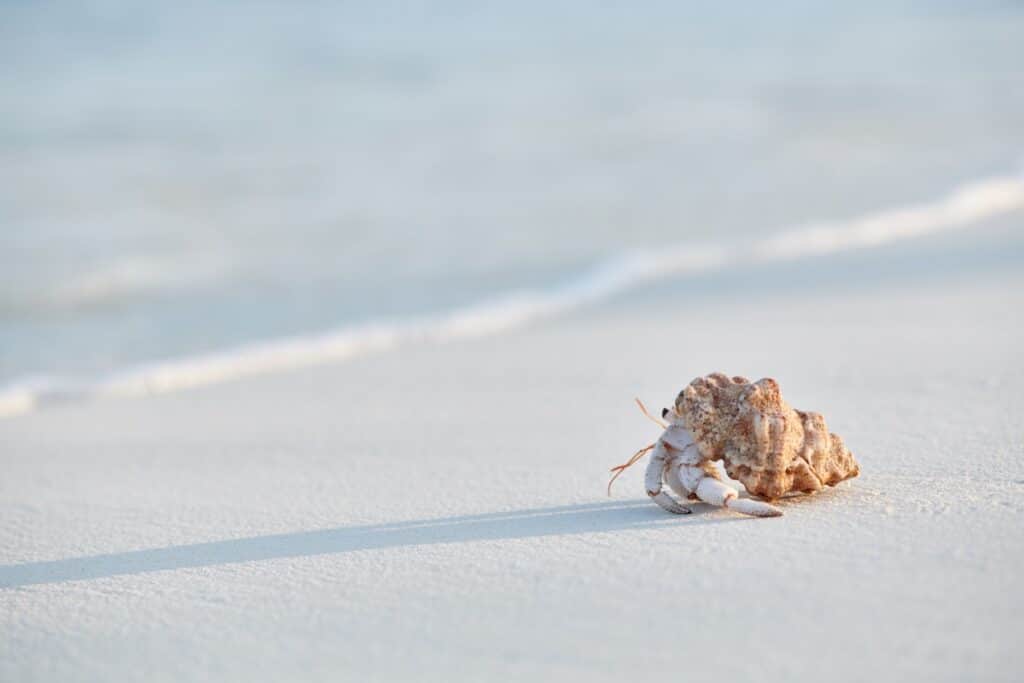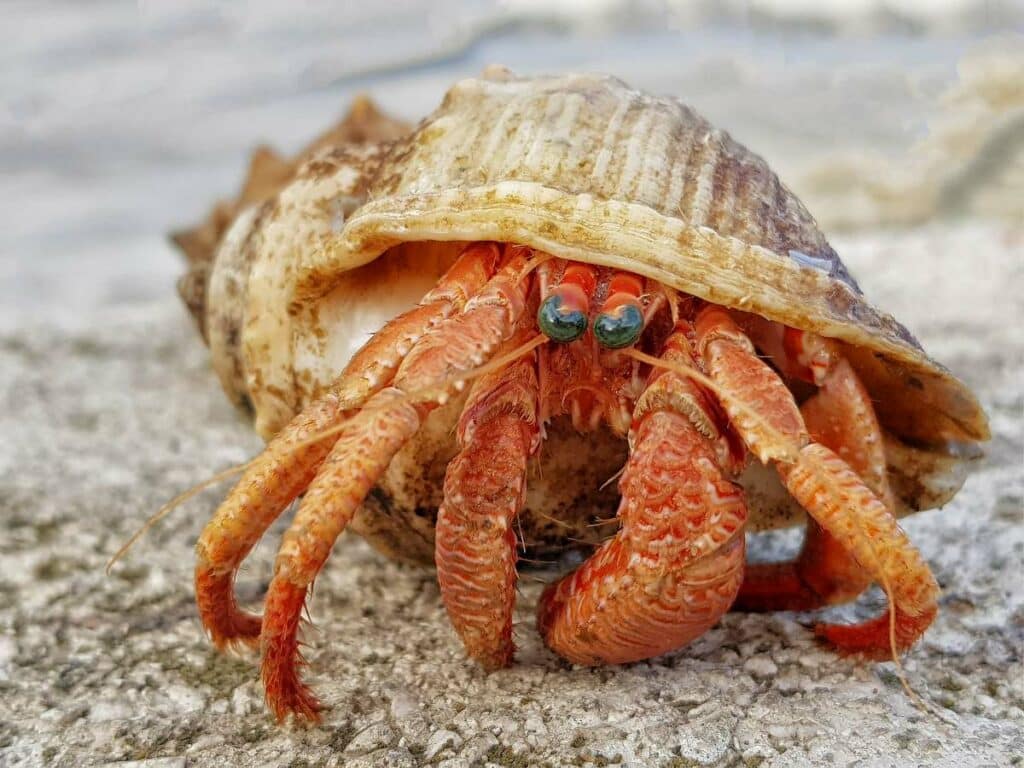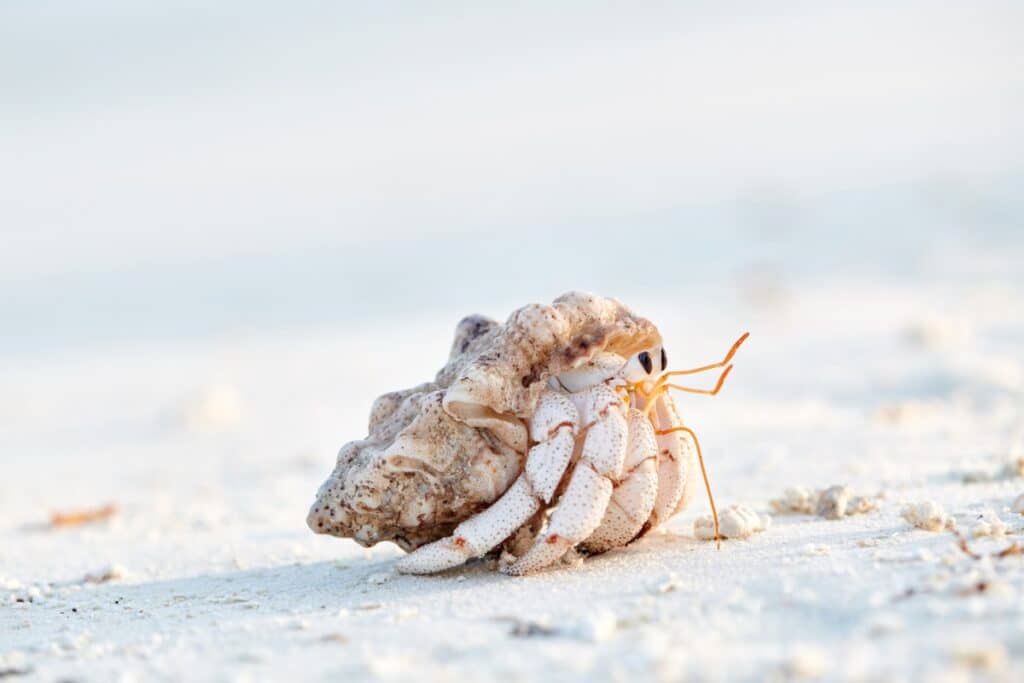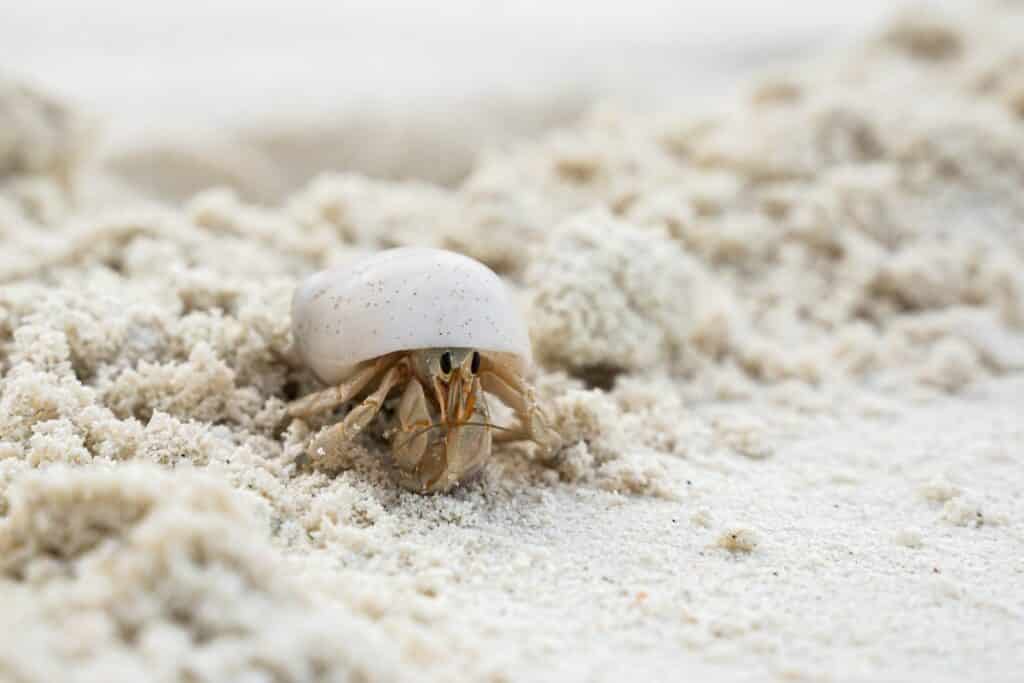the essentials in brief
Hermit crabs are a superfamily of crustaceans. They belong to the order of decapods. They have a soft abdomen that they hide in empty snail shells. More information can be found here.
There are about 1.100 species of hermit crabs, divided into six families.
Some species of hermit crabs, most notably the terrestrial hermit crabs, can be kept as pets. However, you need a special terrarium. You can find more information here.
Hermit crabs are a group of crustaceans that live in empty snail shells or other cavities. You can find them in many seas and coastal regions of the world. However, some species have also adapted to life on land. In this blog post you will learn everything about these fascinating animals: how they look, how they live, what they eat and how to keep them in a species-appropriate manner.
Features and Specialties

As decapods have hermit crabs five pairs of limbs: a pair of scissor legs, two pairs of walking legs that protrude from the case, and two pairs of smaller legs that they use to hold the case in place. The scissor legs are often different sized. They serve to close the entrance of the snail shell. The walking legs have mostly small claws or hooks, which allow them to cling to rough surfaces.
The hermit crab's abdomen is soft and unprotected. It is often spirally twisted or curved to conform to the case. He also has small attachments, the pleopods to be named. They can have different functions: In the males, they serve to sperm transfer, in the females to attach the eggs and in some species for respiration.
key fact box
An important difference between male and female hermit crabs is that males typically have smaller claws than females, while females have larger and more robust claws to help them with egg laying and brood care.
The hermit crabs have a well-developed head with two pairs of eyes: a pair of stalk eyes, which can protrude from the housing, and a pair of spotted eyes on the headboard. They also have two pairs of sensors: a long pair of antennae to touch and smell and a short pair of antennae to touch.
The color of hermit crabs varies by species and habitat. You can brown, grey, green, red or bunt be The body of some species is also patterned or spotted.
lifestyle and behavior
Hermit crabs are found in many seas and coastal regions around the world. They mainly live in shallow waters such as reefs, lagoons or intertidal zones. However, some species have also adapted to a Adapted to deep sea or land life.
Hermit crabs are omnivores that differ from various feed on organic matter. For example, they eat algae, plants, worms, plankton, fish or carrion. For the Grasping, crushing or peeling their food they use their claws. They also have a muscular stomach with teeth. This allows them to break down their food further.
Note: To find hermit crabs, look for clam shells that can serve as shelter in coastal areas with sandy or pebbly bottoms, particularly on sea shores or in tide pools.
Hermit crabs are social animals that often live in groups. They understand each other among themselves through sounds, gestures or chemical signals. They also display various forms of social behavior such as Cooperation, competition or aggression.
Hermit crabs have been known to feed on a regular basis change their habitat. you are looking for empty snail shells or hollow objectsthat are large enough for their abdomens. With their feelers and legs they check the quality and fit of the potential housing. Once they have found a suitable home, they quickly leave their old one and move into the new one.
Hermit crabs often have to fight for or defend their homes. They may attack or threaten other hermit crabs in order to steal their homes. You can also use theirs Use scissors or their case as a weapon. Some species also form chains or rows of hermit crabs that help each other find suitable shelter.

reproduction and development
hermit crabs are segregated sex. There are male and female animals. The males are usually equipped with larger claws than the females. Mating usually takes place near the water instead of. The males transfer their sperm to the females with the pleopods.
The females wear them fertilized eggs on her abdomen. They are under the shell. The number of eggs can vary depending on the species a few hundred and several million. The eggs are usually green or blue in color.
Additional information: How long it takes for a hermit crab to hatch from the egg depends on the species. In some species, this process can be completed in just a few weeks, while in other species it can take several months. However, there is no standard duration as it depends on environmental conditions and species.
The development of hermit crabs is indirect, that is, they go through several larval stagesbefore they become adult animals. The females release the larvae into the water, where they swim freely and feed on plankton. The larvae, the one hard shell and long spines have, become Zoea mentioned.
In order to become larger and more complex, the zoea molt several times. After a few weeks or months, they transform into another larval form, the glaucothoe. The Glaucothoe have one soft abdomen and look for a small living space. Depending on the species, they sink to the bottom of the sea or go ashore.
The hermit crabs molt again. You will young hermit crabs. They keep growing and change their dwelling several times, until they are sexually mature. The lifespan of hermit crabs can range from a few years to several decades, depending on the species.
attitude and care
Hermit crabs can be kept as pets. The requirement is that they correct housing conditions find. Especially hermit crabs are popular terrarium animals, as they are relatively easy to care for and interesting to watch.
To keep hermit crabs you need a special terrarium with the following features:
- lots of sand as substrate so that the animals can dig
- shallow water holes with salt and fresh water so that the animals can drink and wet their gills
- the humidity should be between 70 and 90%. The animals should not dry out
- an appropriate temperature of 26-28 °C during the day and at least 21 °C at night to prevent the animals from becoming hypothermic
- good ventilation so the air doesn't get too stuffy
- sufficient lighting to simulate a day-night rhythm
- enough space for several animals, at least 80 x 40 x 40 cm
Attention: A thermometer and a hygrometer are required to set up the terrarium in order to be able to measure the temperature and humidity
Hermit crabs are fed daily. The lining should varied and in small quantities Tobe offered. The water is changed regularly. The terrarium should be kept clean and all debris removed.
Hermit crabs should in groups of at least three animals being held. They should only be socialized with conspecifics of the same species. They should not be kept together with other animals that could disturb or injure them.
Hermit crabs should be observed regularly to check their well-being. they should not be disturbed or touched unnecessarily. You should not force or use force be removed from their housing. They must not be stressed or abused.

Diverse animals
Hermit crabs are so exciting animals that know a lot about the Diversity and adaptability of life can tell on earth. With species-appropriate husbandry and care, they are too interesting petsthat can bring a lot of joy.
They are social animals that often live in groups. With the help of sounds, gestures or chemical signals communicate with each other. They also show different forms of social behavior such as cooperation, competition or aggression. Before they become adults, they go through several larval stages.
Sources
- https://www.spiegel.de/wissenschaft/natur/schuechterne-einsiedlerkrebse-sind-fruchtbar-a-1017754.html
- https://www.nationalgeographic.de/tiere/2020/01/einsiedlerkrebse-groessere-penisse-bewahren-vor-obdachlosigkeit
- https://www.welt.de/wissenschaft/tierwelt/article110327002/Warum-Einsiedlerkrebse-Immobilienpartys-feiern.html


